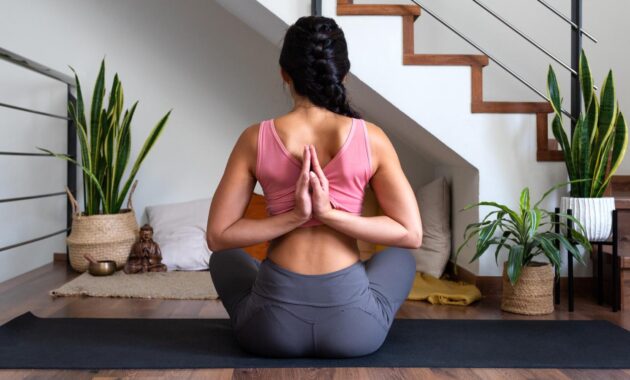The reverse prayer yoga pose works specifically on your arms and abdomen. Here are the benefits of pashchima namaskarasana and how to do it.
Reverse prayer yoga, also known as Pashchima Namaskarasana (or Parshva Namaskarasana), is a pose in which you join your hands behind your back. This is an upper-body strengthening pose that targets the arms and abdomen. It also focuses on your shoulders and wrists. Plus, it aids in burning arm fat by toning the muscles. It is an extremely beneficial yoga pose for people who spend long hours sitting in front of a laptop. One of the best things about this yoga pose is that it can be performed at your study table or while using a laptop at your office desk. It is also great to get rid of stress and tension as it helps strengthen your back and shoulders. Let’s learn how to do reverse prayer yoga and what are the other benefits of this yoga pose.
What is the reverse prayer yoga pose?
This pose is an upper-body strengthening pose that works for the abdomen and arms. There are numerous names for the Reverse Prayer Pose, including Penguin Pose, Pashchima Namaskarasana, and Viparita Namaskarasana. It is a variation of the Tadasana that works specifically on your arms and abdomen.

4 benefits of reverse prayer yoga
Here are some of the potential benefits of reverse prayer yoga:
1. Aids in digestion
The shoulder movements promote digestion by opening up the chest. In addition to improving your breathing, they support physical health and metabolism.
2. Helps to strengthen the tendons
“The shoulder movement is particularly beneficial for those with carpal tunnel syndrome and wrist pain as it strengthens the tendons in your wrists. Doing this easy yoga reverse prayer pose will help you avoid harm to your wrists if you find yourself typing even 300 words in a single day. The extension will cause numerous acupuncture points on the wrists to become active,” says Yoga Expert, Dr. Hansaji Yogendra.
Also Read

3. Reduces neck and shoulder pain
The shoulder movement relieves tension in the shoulder muscles, relaxes the shoulder blades, and reduces pain in the neck.
Also Read: Yoga for neck pain: Do these 7 stretching exercises just 5 minutes a day for relief
4. Keeps stress at bay
The pose might help you relieve tension and calm an anxious mind. This easy asana will help you relieve tension at work or home because a calm mind leads to a calm body. It can assist in achieving harmony between your body, mind, and spirit.
How to do reverse prayer yoga or pashchima namaskarasana?
Here is a complete guide on how to do reverse prayer yoga, as explained by the expert.
- Step 1: Begin in a comfortable seated position on a yoga mat, with your spine straight and legs extended in front of you.
- Step 2: Gently warm up your shoulders and wrists by rotating them in circular motions.
- Step 3: Reach your arms behind your back and attempt to bring the palms of your hands together. Start by bringing the back of your hands towards each other.
- Step 4: Aim to bring your hands into a prayer position behind your back.
- Step 5: Ensure that your elbows are pointing upward and not splaying out to the sides. This helps in maintaining the alignment of your arms and shoulders.
- Step 6: As you pull your hands closer together, raise your chest and spread your shoulders. This exercise stretches your shoulders and chest.
- Step 7: Focus on your breath. Inhale deeply to expand your chest, and exhale to relax into the pose. Maintain slow, controlled breathing throughout the posture.
- Step 8: Hold reverse prayer yoga pose for 20-30 seconds or longer, depending on your comfort level. Feel the stretch in your wrists, forearms, and shoulders.
- Step 9: Slowly release the pose by bringing your hands back to the front of your body. Shake your wrists and shoulders to release any tension.
- Step 10: If you wish to deepen the stretch or practise the pose further, you can repeat this pose after a short break.
Note: If you experience any pain or discomfort, especially in the wrists or shoulders, ease out of the pose.
Who should avoid doing reverse prayer yoga?
People with low blood pressure or those with arm or shoulder injuries are advised to refrain from practising reverse prayer asana, as this yoga pose involves bringing the hands behind the back, which may exacerbate existing conditions. Always prioritise your safety and consult with a healthcare professional to avoid risks.

Best time to perform reverse prayer yoga
You can practise reverse prayer yoga in the morning or evening before beginning your fitness routine. This will help you open up your body and help you become more flexible.
#Reverse #prayer #yoga #pose #Benefits #pashchima #namaskarasana
